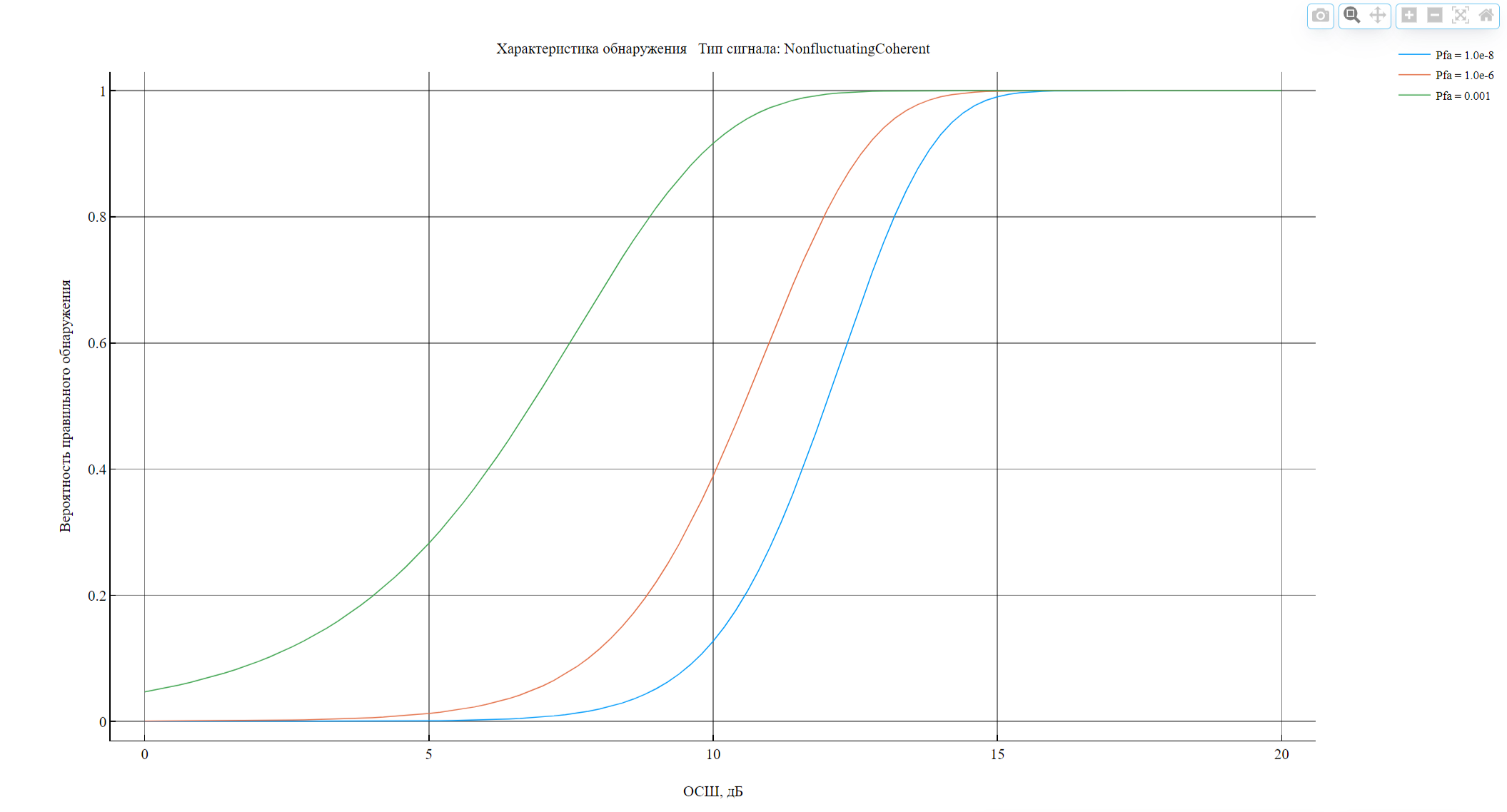rocpfa
Receiver performance curves for false alarm probability.
| Library |
|
Syntax
Creation
The rocpfa function can be called in the following ways:
-
Pd,SNR = rocpfa(1e-6, "Pd&SNR")returns the single pulse detection probabilities, argument Pd, and the required signal-to-noise ratio values, argument SNR, SNR for the false alarm probabilities in a vector of rows or columns Pfa. By default, for each false alarm probability, detection probabilities are calculated for 101 equally spaced SNR values ranging from 0 to 20 dB. The ROC curve is plotted assuming a single pulse in a coherent receiver with an unchanging target.
Arguments
Entry
Pfa -.
false alarm probability
vector
Details
The probability of a false alarm, given as a vector of rows or columns.
Example: [1e-8 1e-6 1e-3].
Data types: Float64
Arguments with value assignment Name=Value
Specify optional argument pairs in the form Name1=Value1,…,NameN=ValueN, where Name is the name of the argument and Value is the corresponding value. The arguments Name=Value must be placed after the other arguments, but the order of the pairs does not matter.
Example: MaxSNR=15,NumPoints=64,NumPulses=10.
MaxSNR -
maximum signal-to-noise ratio (SNR) to be included in the ROC calculation
20 (By default)| positive scalar
Details
The maximum signal-to-noise ratio (SNR) to include in the ROC calculation, specified as a positive scalar.
Data types: Float64
MinSNR -
minimum signal-to-noise ratio (SNR) to be included in the ROC calculation
1e-10 (by default)| positive scalar
Details
The minimum signal-to-noise ratio (SNR) to be included in the ROC calculation is specified as a positive scalar.
Data types: Float64
NumPoints -
number of signal-to-noise ratio (SNR) values used in the calculation of ROC curves
101 (By default) | Positive integer
Details
The number of SNR values used in the calculation of ROC curves is set as a positive integer. The actual values are equidistant between MinSNR and MaxSNR.
Data types: Float64
NumPoints -
number of signal-to-noise ratio (SNR) values used in the calculation of ROC curves
101 (by default) | `positive integer'.
Details
The number of SNR values used in ROC curve calculation is set as a positive integer.
The actual values are equidistant between the values of the MinSNR and MaxSNR arguments.
Data types: Float64
NumPulses -
number of pulses for integration
1 (by default) | `positive integer `
Details
The number of pulses to integrate for ROC curve calculation, set as a positive integer.
A value of 1 means no pulse integration.
Data types: Float64
SignalType — type of received signal
NonfluctuatingCoherent (By default) | NonfluctuatingNoncoherent | Real | Swerling1 | Swerling2 | Swerling3 | Swerling4
Details
This argument specifies the type of received signal or, equivalently, the probability density functions (PDF) used to calculate the ROC.
It is specified as one of the values:
-
Real. -
NonfluctuatingCoherent. -
NonfluctuatingNoncoherent -
`Swerling1
-
`Swerling2
-
`Swerling
-
`Swerling4
Values are not case sensitive.
The `NonfluctuatingCoherent' signal type assumes that the noise in the received signal is a complex Gaussian random variable. This variable has independent zero mean real and imaginary parts, each with variance under the null hypothesis. In the case of a single pulse in a coherent receiver with complex white Gaussian noise, the probability of detection, , for a given false alarm probability, , is equal to:
where and are the additive error function and its inverse function, and is the dimensionless signal-to-noise ratio (SNR).
Data types: char, string
Output
Pd -
detection probability
vector
Details
Detection probabilities corresponding to false alarm probabilities, returned as a vector. For each false alarm probability in the argument Pfa, Pd contains one column of detection probabilities.
Data types: Float64
SNR -
signal-to-noise ratio
`column vector
Details
Signal to noise ratio, returned as a column vector.
By default, SNR values are 101 evenly distributed values from 0 to 20.
-
To change the range of SNR values, use the optional input argument MinSNR or MaxSNR.
-
To change the number of SNR values, use the optional input argument NumPoints.
Data types: Float64
